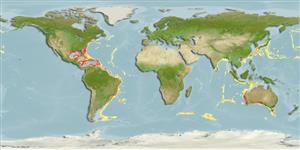Bathynomus giganteus Milne-Edwards, 1879
Giant isopod| Native range | All suitable habitat | Point map | Year 2050 |

|
| This map was computer-generated and has not yet been reviewed. |
| Bathynomus giganteus AquaMaps Data sources: GBIF OBIS |
Google image |
No photo available for this species.
Classification / Names Common names | Synonyms | CoL | ITIS | WoRMS
Malacostraca | Isopoda | Cirolanidae
Environment: milieu / climate zone / depth range / distribution range Ecology
Bathydemersal; depth range 310 - 2300 m (Ref. 3113), usually 365 - 730 m (Ref. 80749). Deep-water
Distribution Countries | FAO areas | Ecosystems | Occurrences | Introductions
Indo-West Pacific and Western Atlantic.
Length at first maturity / Size / Weight / Age
Maturity: Lm 18.0 range ? - ? cm Max length : 50.0 cm TL male/unsexed; (Ref. 99323)
Short description Morphology
Life cycle and mating behavior Maturity | Reproduction | Spawning | Eggs | Fecundity | Larvae
Main reference
References | Coordinator | Collaborators
Schotte, M., B.F. Kensley and S. Shilling 1995 World list of marine, freshwater and terrestrial crustacea isopoda. National Museum of Natural History Smithsonian Institution: Washington D.C., USA. Http://www.nmnh.si.edu/iz/isopod/ [Accessed 07/03/01]. (Ref. 3113)
IUCN Red List Status
(Ref. 130435: Version 2025-1)
CITES status (Ref. 108899)
CMS (Ref. 116361)
Threat to humans
Human uses
Fisheries: of no interest
| FishSource |
Tools
More information
Max. ages / sizes
Length-weight rel.
Length-length rel.
Length-frequencies
Mass conversion
Abundance
Internet sources
BHL | BOLD Systems | CISTI | DiscoverLife | FAO(Publication : search) | Fishipedia | GenBank (genome, nucleotide) | GloBI | Gomexsi | Google Books | Google Scholar | Google | PubMed | Tree of Life | Wikipedia (Go, Search) | Zoological Record


